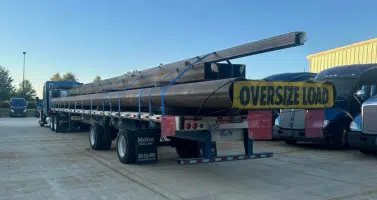
Top 5 Challenges in Cross-Border Shipping (And How to Avoid Them)
In today’s shipping landscape, international shipping has become key for businesses to increase their efficiency and reach. The U.S.-Mexico-Canada agreement was established in 2020 to make cross-border shipping easier and more cost-efficient, and nearshoring (the practice of moving manufacturing centers to neighboring countries in place of offshore production) has increased exponentially, with Mexico and Canada surpassing China as the United States’ top trade partners as of August 2024.
With this emphasis on shipping within North America, understanding the intricacies of cross-border shipping is more important than ever. In this blog, we discuss five of the biggest challenges associated with shipping internationally and how shippers and carriers can overcome them.
1. Border Wait Times and Delays
Challenge: Cross-border shipping has more regulations than domestic shipping, so wait times at border crossing stations can get out of hand fast. Sometimes, it can take hours to make it through a checkpoint, costing you more money and time.
How to Solve: The best way to avoid delays is to prepare! Know ahead of time what could potentially hold you up – are you hauling hazardous materials that need additional permits to cross a border? Is your cargo properly labeled? Did you digitally submit documents ahead of time, or will they need to be reviewed by a customs agent when your shipment reaches the border? Ensuring you do everything you can to prepare your cargo will make your border crossing experience much smoother. If you’re planning on letting another company handle the shipping process, be sure they’re experienced in international shipping.
2. Language and Cultural Barriers
Challenge: Language and cultural differences between the United States, Mexico, and Canada can make communication take much longer than normal. This also increases the chance of mistakes if either party has a misunderstanding with the shipment.
How to Solve: Collaborating with a bilingual logistics team with experience in cross-border shipping is the best way to circumvent these communication issues altogether. Not only can they communicate with the customs agents to expedite the border crossing process, but they can also explain the reasonings behind a miscommunication and help both parties avoid it in the future.
3. Accomodating Specialized Freight
Challenge: Not every border crossing point is equipped the same, and loads that are oversized or contain specialized materials may not be permitted to cross at every border crossing, or will require shipments to be broken down to accommodate a country’s load requirements.
How to Solve: Make sure to plan and research which crossings can accept your shipment. Even if it’s not the quickest route, it will be faster than causing a delay at a crossing point or possibly rerouting your load altogether. If you’re ever in doubt, contact the crossing point directly and confirm their rules for over-dimensional and specialized loads.

4. Adhering to Load Securement/Safety Standards
Challenge: Safety standards for loads can vary from country to country, especially with flatbed loads. Not adhering to each country’s safety standards can result in fines, delays, or prevent a load from crossing altogether. When shipping through Mexico, you may also be required to transload your freight onto another trailer before it can cross the border.
How to Solve: Make sure the drivers you work with are trained in load securement practices and be informed of securement requirements for both countries your freight will be traveling through. You may be required to adjust your load before you cross, so make sure it’s completed before any delays occur.
To further speed up this process, work with a company with through-trailer service capabilities, like Melton Truck Lines. Instead of unsecuring a load, moving it onto another trailer, and resecuring it, Melton is permitted to use the same trailer from the shipment’s origin to its final destination. This can save hours at the border and prevent the potential securement errors that come from resecuring the load.
5. Customs Compliance and Documentation Errors
Challenge: Depending on your shipment, carrier status, country of origin, and destination country, the paperwork and documentation you need will vary greatly. Not having the proper paperwork on hand can result in fines, huge delays, or a rejected shipment – all of which can cause more costly problems for your business.
How to Solve: Like many other issues, the best way to avoid delays caused by improper documentation is to be prepared ahead of time. Digitally submitting your required documentation ahead of time will give you time to fix any errors before you reach a checkpoint, and will make the process much smoother when you reach the crossing point.
While each load will likely require unique documentation, here are some of the most common documents you’ll need before you ship across a border:
- Bill of Lading (BOL): The BOL is an important document that contains information about the freight like its weight and classification. It also serves as an agreement between the shipper and carrier, outlining terms for the transportation of the shipment.
- Certificate of Origin (CO): The Certificate of Origin officially certifies where your cargo was produced and ensures it meets all applicable trade standards.
- Shipper’s Letter of Instruction (SI): A Shipper’s Letter of Instruction is filled out by the shipper and given to the carrier. This document will contain information about how the freight should be handled, information about the load and the two parties, and any additional terms agreed on between them.
- Packing List (PL): A Packing List will have an outline of all the contents in a shipment like measurements, weight, and number of items.
- Commercial Invoice (CI): The Commercial Invoice acts as a receipt between the shipper and customer, and contains information about both parties and the cargo being sold. It will contain information like the country of manufacture, the value of the goods, the terms of sale, and information about the purchase when applicable.
Cross-border shipping is more complex than domestic shipping, but it doesn’t need to be an intimidating experience. The best way to avoid incidents is to be prepared and work with an experienced carrier who knows the ins and outs of international shipping, like Melton Truck Lines. Our over 40 years of cross-border experience, CTPAT certification, bilingual staff, through-trailer services, and large fleet all work together to make your international shipments more cost-effective and efficient. If you want to learn more about our cross-border shipping services, visit our international shipping page.
